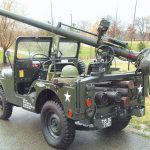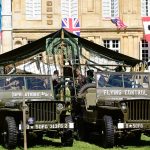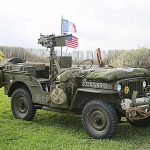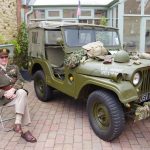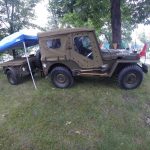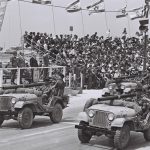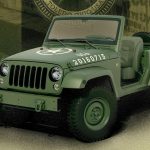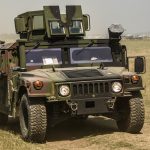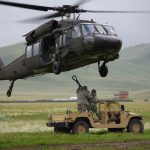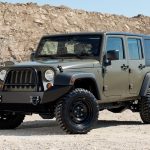It is a well known fact: the Jeep started it’s long life as a military vehicle, being commissioned by the US Army during World War 2. After it’s more than distinguished service during the Second World war, the civilian branch started to develop into the Jeep Wrangler that we all know and love today. But what happened with the military Jeeps? Did they disappear after the end of the war?
During WW2, the Jeep served a myriad of duties: transport of troops, towing supply trailers, carrying fuel, ammo and water while on scouting and reconnaissance duty. The Jeeps were also used as ambulances and hearses, command HQs and as weapons platforms… from british Vickers to 30 and 50 caliber Machine Guns and grenade launchers. The flat hood was used as a commander's map table, a chaplain's field altar, the G.I.s' poker table, and even for field surgery. All while pulling through the most difficult terrain across the globe, as the Jeeps were present in all WW2 theaters.
After American Bantam (the legal owner of the Jeep brand) went bankrupt, WIllys Overland and it’s successor Willys Motors and Kayser Jeeps (you can read the full history on our “Ownership” page) continued to build jeeps for the military until the late 60’s. The first post WW2 Jeep was the M38 also known as Jeep MC which came with a few improvements and modifications compared to the M38/MB such as: reinforced frame and suspension, sealed vent system for the engine, transmission, transfer case, fuel system and a waterproof electrical system to name just a few. There were over 60,000 units built which served in the Korean War.
The Jeep M38/MB was followed by M38A1/MD which had a longer life than its predecessor, being built until 1971 with production totalling more than 100,000 units. This military model was used to build the highly successful civilian version CJ-5, which continued with CJ-6,CJ-7 and finally ending with the CJ-8 model in 1986 - the CJ line total production went well over 1.5 million units.
Beside the all-new body style, M38A1/MD came with new transmission, engine choices, transfer case as well as front and rear axles. It was used in a variety of roles, from ambulance to weapons platform: the M38A1C variant came with the M40A1 106mm recoilless rifle mounted and was used by all US military branches including a special version used by the US Marine Corps.
Other countries and allies to the United States also built a number of variants widely used in their respective military forces:
- The Netherlands produced the Nekaf Dutch variant
- Canada manufactured a number of different models: M38A1Cdn, M38A1Cdn2, and M38A1Cdn3
- South Korea produced the KM-41 and Keohwa M-5GA1 versions
In the early 60’s, Ford (and later Kaiser as well as AM General Corp, a subsidiary of AMC) was awarded a military contract to design and build a ¼-ton 4×4 truck to replace the aging M38 and M38A1 model jeeps. Ford manufactured the M151 truck with what was intended a completely new design under the body which retained most of the earlier Jeep body style. The M151 was built on an integrated chassis as opposed to the steel tub bolted onto a separate steel frame used by Willys as well as an independent suspension system moving away from the traditional solid axle design of the Jeep (design which is still produced in 2020).
Because of trademark issues, the 7-slot vertical grille could not be used so Ford used a 7-slot horizontal grille. This vehicle was never produced for the civilian market due to its inability to meet higher safety standards. The M151 suffered from a rear suspension design issue which made the vehicle highly prone to roll-over.
By introducing the M151A2 model, the handling issues were eventually resolved by a redesign of the rear suspension.. However, due to liability concerns, the U.S. Department of Defense deemed all M151 series vehicles "unsafe for public highway use", limiting their public use. Continuing problems with vehicle roll-overs into the 1980s led the U.S. military to retrofit many M151 series vehicles with the "Roll over protection structure" (ROPS), a roll cage intended to protect both front and rear seat passengers.
The M151 played an active part in American military operations well into the 1980s, when it was phased out in favor of the HMMWV (or Humvee or Hummer). Despite its official replacement, the M151 had some distinct advantages over its much larger and heavier successor, like being small enough to fit inside a CH-53 heavy transport helicopter. This flexibility was one of the reasons the U.S. Marines Corps deployed M151 Fast Attack Vehicle up until 1999, in theatres such as Kosovo. It currently serves in U.S. special forces units as a FAV.
The M151 played an active part in American military operations well into the 1980s, when it was phased out in favor of the HMMWV (or Humvee or Hummer). Despite its official replacement, the M151 had some distinct advantages over its much larger and heavier successor, like being small enough to fit inside a CH-53 heavy transport helicopter. This flexibility was one of the reasons the U.S. Marines Corps deployed M151 Fast Attack Vehicle up until 1999, in theatres such as Kosovo. It currently serves in U.S. special forces units as a FAV.
In 1979, the U.S. Army drafted final specifications for a High Mobility Multipurpose Wheeled Vehicle (HMMWV), which was to replace all the tactical vehicles in the 1/4 to 1 1/4-ton range (the M151 quarter-ton jeep), as one "jack-of-all-trades" light tactical vehicle to perform the role of several existing trucks. The specification called for excellent on and off-road performance, the ability to carry a large payload, and improved survivability against indirect fire. Compared to the Jeeps, it was larger and had a much wider track, higher ground clearance, double that of most sport-utility vehicles. The new truck was to climb a 60 percent incline and traverse a 40 percent slope and the air intake was to be mounted flush on top of the right fender and electronics waterproofed.
The military Jeep took part in over 25 wars and conflicts, from the Korean Wars, Cuban Revolution, Congo Crisis and Vietnam War to Indo-Pakistani War of 1971, Soviet–Afghan War and the Croatian War of Independence.
The military operators using various Jeep vehicles include: Bangladesh, Brazil, Canada, Cuba, Croatia, Egypt, Israel, Iran, Netherlands, Pakistan, Portugal, South Korea, Soviet Union and Republic of China.
The military Jeep took part in over 25 wars and conflicts, from the Korean Wars, Cuban Revolution, Congo Crisis and Vietnam War to Indo-Pakistani War of 1971, Soviet–Afghan War and the Croatian War of Independence.
The military operators using various Jeep vehicles include: Bangladesh, Brazil, Canada, Cuba, Croatia, Egypt, Israel, Iran, Netherlands, Pakistan, Portugal, South Korea, Soviet Union and Republic of China.
There also non-state military operators that were (and still are) using extensively the various military Jeep versions. To name just a few: Afghan Mujahideen, Army of Free Lebanon, Arab Democratic Party, Progressive Socialist Party/People's Liberation Army (PLA), Palestine Liberation Organization (PLO), Syrian Social Nationalist Party in Lebanon and Zgharta Liberation Army (a.k.a. Marada Brigade).
Starting with 1983 the HMMVW replaced the venerable Jeep within the US Army various military branches of the United States with more than 45 different versions and it is currently being used by more than 65 nations’ military units.
However, in September 2007, at the Defence Systems & Equipment International (DSEi) trade show, the Jeep J8 was introduced. The Jeep J8 is a military vehicle based on the Jeep Wrangler platform and is assembled in Gibraltar and Israel. AADS has developed and tested the entire range of J8's for deployment to various missions including logistical and front line operations. It is powered by a range of petrol and diesel engines, but the most common engines are the 2.2 litre or 3 litre V6 diesel power units, both mated to an 8-speed automatic transmission.
However, in September 2007, at the Defence Systems & Equipment International (DSEi) trade show, the Jeep J8 was introduced. The Jeep J8 is a military vehicle based on the Jeep Wrangler platform and is assembled in Gibraltar and Israel. AADS has developed and tested the entire range of J8's for deployment to various missions including logistical and front line operations. It is powered by a range of petrol and diesel engines, but the most common engines are the 2.2 litre or 3 litre V6 diesel power units, both mated to an 8-speed automatic transmission.
This Jeep was built using military specs and so, the J8 is equipped with larger brakes (disks all-around), beefier Dana 60 rear differential and upgraded and a more rugged suspension than the civilian version.
The J8 has been submitted as a replacement for the Toyota Tacoma, Toyota Hilux, Mitsubishi Triton and HMMWV for US Special Forces.
The J8 has been submitted as a replacement for the Toyota Tacoma, Toyota Hilux, Mitsubishi Triton and HMMWV for US Special Forces.







